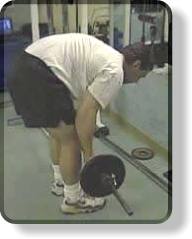Strength and Conditioning Programs: Efficiency May Be All Wrong…
In my strength and conditioning writing, I throw the term “efficient” around quite a bit; in fact, it’s even in the title of our Building the Efficient Athlete DVD set. I’m sure that some people have taken this to mean that we’re always looking for efficiency in our movement. And, certainly, when it comes to getting from point A to point B in the context of sporting challenges, the most efficient way is generally the best.
And, just think about strength training programs where lifters simply squat, bench press, and deadlift to improve powerlifting performance. The goal is to get as efficient in those three movements as possible.
And, you can look at NFL combine preparation programs as another example. Guys will spend months practicing picture-perfect technique for the 40-yard dash. They might not even get faster in the context of applicable game speed, but they get super efficient at the test.
However, the most “efficient” way is not always the right way.
In everyday life, efficiency for someone with poor posture means picking up a heavy box with a rounded back, as it’s the pattern to which they’re accustomed, and therefore less “energy expensive.” This would simply prove to be an efficient way to get injured! I’d rather lift things safely and inefficiently.
And, take those who run long distances in hopes of losing fat as another example. The research has actually shown that runners burn fewer calories for the same given distance after years of running improves their efficiency. While this improvement is relatively small, it absolutely stands to reason that folks would be smart to get as inefficient as possible in their training to achieve faster fat loss. In other words, change modalities, intensities, durations, and other acute programming variables.
Training exclusively for efficiency on a few lifts might make you better at those lifts, but it’s also going to markedly increase your risk of overuse injuries. I can say without wavering that we’d see a lot fewer knee and lower back injuries in powerlifters if more of them would just mix in some inefficient single-leg training into their strength training programs. And, shoulders would get a lot healthier if these specialists would include more inefficient rowing variations and rotator cuff strength exercises.
In the world of training for athletic performance, it’s important to remember that many (but not all) athletes perform in unpredictable environments – so simply training them to be efficient on a few lifts fails to fully prepare them for what they’re actually face in competition. A strength and conditioning program complete with exercise variety and different ranges-of-motion, speeds of motion, and magnitudes of loading provides athletes with a richer proprioceptive environment.
In other words, inefficiency in strength and conditioning programs can actually facilitate better performance and a reduced risk of injury.
Taken all together, it’s safe to say that we want inefficiency in our training, but efficiency in our performance – provided that this efficiency doesn’t involve potentially injurous movement patterns.
Related Posts
Why I Don’t Like 5×5 Strength Training Programs
Weight Training Programs: The Basics, but with Variety




